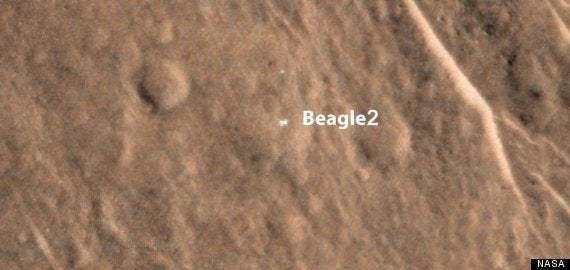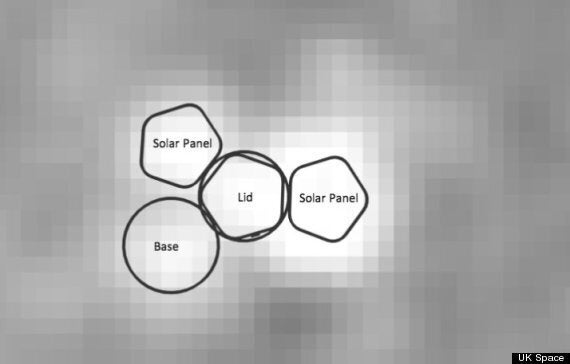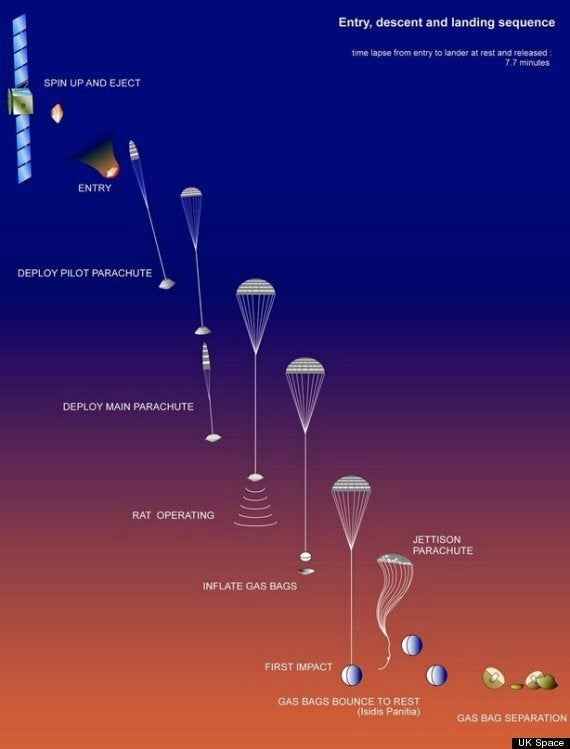The UK's Beagle 2 Mars probe, thought lost on the planet in 2003, has been found.
The craft, which resembled a giant pocket watch, was supposed to land softly on Mars and deploy an array of instruments and solar panels to help search for life.
It travelled to the planet with the European Space Agency's Mars Express craft, but contact was lost shortly after it made its way to the surface on Christmas day.
For more than a decade it was thought that the probe was lost, but scientists continued to scour the surface with images taken aboard NASA's Mars Reconnaissance Orbiter.
And now, it has been found.
"What we can say today with some confidence is that Beagle 2 is no longer lost," said Dr. David Parker, CEO of the UK Space Agency in a press conference at the Royal Society in London.
The find makes Beagle 2 a "successful failure" said the UK Space Agency. It technically makes it the first European probe to successfully land on another planet.
Parker said that there is good evidence from the NASA Hi-RISE space craft that the probe is "resting on the surface of Mars".
"We are not looking at a crash site," he said. "These images are consistent with Beagle 2 having successfully landed on Mars but only partially having deployed."


Above: the lander was photographed by NASA's HI-RISE camera in orbit around Mars
The reaction to the news was enormous on social media - though much of the response focused on the sad fact that Professor Colin Pillinger, who spearheaded the project, died just months before the probe was found.

UK Space explained:
"The image... show the Beagle 2 lander in what appears to be a partially deployed configuration, with what is thought to be the rear cover with its pilot/drogue chute (still attached) and main parachute close by. Due to the small size of Beagle 2 (less than 2m across for the deployed lander) it is right at the limit of detection of imaging systems (cameras) orbiting Mars. The targets are within the expected landing area at a distance of ~5km from its centre.
Several interpretations of the image of the lander have been identified, consistent with the lander’s size and shape. The imaging data is however consistent with only a partial deployment following landing. This would explain why no signal or data was received from the lander – as full deployment of all solar panels was needed to expose the RF antenna which would transmit data and receive commands from Earth."
This is a sharpened image of the pixels that UK Space says is the lander:

The UK Space Agency also posted this image explaining what happened to the probe.

Ahead of the conference David Rothery, professor of planetary geosciences at the Open University, said he believed pictures will be published today proving that the spacecraft's lander successfully touched down on the Red Planet in 2003 but that a malfunction prevented it from beaming information back to Earth.
Rothery said: "What I think we are going to have revealed tomorrow is pictures showing Beagle 2 on the ground, what is thought to be Beagle 2 on the ground.
"It looks like they (the panels) didn't all open."
He added: "I regard it as being more successful than we perhaps though 12 years ago when we lost it. It would be nice to know if it landed close to where we think it did."
Prof Mark Sims from the University of Leicester's Space Research Project said:
"Every Christmas Day since 2003 I have wondered what happened to Beagle 2. My Christmas day in 2003, alongside many others who worked on Beagle 2, was ruined by the disappointment of not receiving data from the surface of Mars. To be frank, I had all but given up hope of ever knowing what happened to Beagle 2.
"The images show that we came so close to achieving the goal of science on Mars. The images vindicate the hard work put in by many people and companies both here in the UK and around Europe and the world in building Beagle 2.
"The highly-complex entry, descent and landing sequence seems to have worked perfectly and only during the final phases of deployment did Beagle 2 unfortunately run into problems. I view it as a great achievement that the team built Beagle 2 in a little over four years and successfully landed it on the surface of Mars.
"It was a great pity we couldn't have delivered the world-class science Beagle 2 may have brought and even sadder that Colin and other colleagues who died in 2014 didn't live to see the discovery that Beagle 2 made it to Mars."
Named in honour of Charles Darwin's famous ship, Beagle 2 was a unique space mission in that it was largely funded by private donations and money raised by promotional campaigns led by the late Professor Colin Pillinger.
The probe was carried by the Mars Express spacecraft, which was blasted into pace by a Russian rocket from Kazakhstan in June 2003.
The mission's call-sign was composed by the Britpop band Blur, and the "test card" used to calibrate the probe's cameras and spectrometer instruments after the landing was painted by Damien Hirst.
It was scheduled to put down in a near-equatorial region of Mars known as Isidis Planitia on December 26. But after detaching from the Mars Express and heading for the surface it was not heard from again.
Despite its small size and shoestring cost Beagle 2 contained some sophisticated hardware.
Elements of its miniaturised technology will be employed on ExoMars, the European rover that will be sent to Mars to search for signs of life in 2018.
And alas - no, it's not possible to get the lander working now we know where it is.
"Unfortunately given the partial deployment (and covering of the RF antenna) it would not be possible to revive Beagle 2 and recover data from it," UK Space said.